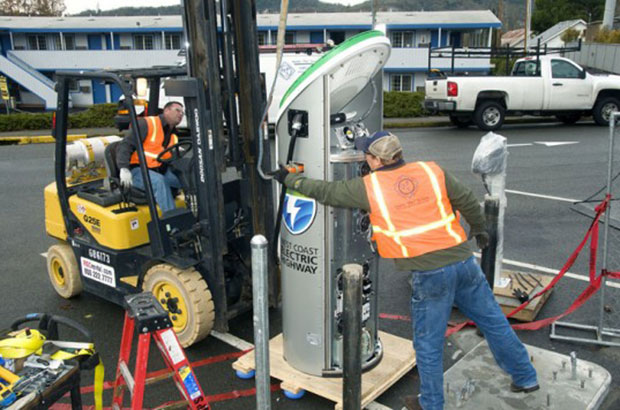On February 2, the first day of the Oregon Legislature, the Senate Environment & Natural Resources committee will address clean fuels for our state’s transportation sector, a sector that is well-positioned to move to a cleaner future, with health and economic benefits to Oregonians across the state.
Oregon’s cars and trucks produce over one-third of the state’s carbon pollution, contributing significantly to global warming. Our state’s own Global Warming commission gave Oregon a “D” grade for failing to commit to cleaner fuels.
To keep the wheels turning on cars and trucks in our economy, improve air and water quality, and provide new business opportunities for urban and rural communities, we need to develop cleaner alternatives. By requiring oil companies to reduce the carbon pollution from their products by 10% over the next 10 years, Oregon’s Clean Fuels Program will grow the supply of low carbon fuel alternatives while giving consumers more and cheaper fuel choices that are better for our air and climate.
But to realize these benefits, the Clean Fuels Program – written into state law back in 2009 – must be reauthorized by our state elected officials, or it will sunset later this year. I hope legislators act quickly this session to move the Clean Fuels Program forward.
>>> TAKE ACTION: Urge your legislators to vote in support of clean fuels
Already, hundreds of businesses from across the state are calling for cleaner fuels in Oregon. Over 150 business have endorsed the Clean Fuels Program – including the Oregon Business Association, which represents a wide range of Oregon industry sectors and represented by stakeholders with diverse points of view. Additionally, over 275 businesses in Oregon signed the Oregon Business Climate Declaration, calling cleaner fuels and other efforts to tackle climate change “one of Oregon’s greatest economic opportunities of the 21st Century.”
EV engines revving with Oregon's Clean Fuels Program
One great opportunity for clean fuels is found in the Electric Vehicle sector. Electric Vehicles (EVs) are a commercially available, proven technology built for success with Oregon’s Clean Fuels Program to reduce our transportation emissions over time. Here’s why:
1) The cheapest gas is the stuff you don’t buy
The growth of EVs is good for Oregon consumers – for their wallets, as well as their health. According to data from Clean Cities, running a light duty EV with electricity costs roughly 3 to 5 cents per mile, compared to a gas-powered car at 14 cents per mile. If 15,000 miles are driven annually, driving the EV could save the average Oregonian $1,300 to $1,600 in annual fuel costs. EVs are much cheaper to repair and maintain, and produce zero tailpipe emissions.
2) Oregon EV manufacturers on the rise, consumer choices rise with them
Oregon has a flourishing EV manufacturing base that benefits many local businesses along the supply chain, including:
- Brammo
- Arcimoto,
- Intel
- Oregon Iron Works
- LEKTRO
- Mentor Graphics
As of 2013, Oregon's electric vehicle cluster has created more than 1,500 jobs and fueled $266.5 million in economic activity. A working clean Fuels Program can help accelerate this economic activity and job growth.
The Clean Fuels Program will also provide consumers with cleaner, more affordable choices, including EVs. Hybrid vehicle sales in 2013 grew by 14% over 2012, and sales of electric cars grew by 83%, according to Jeff Siegel, with Energy and Capital. We now have 5,086 EVs registered in Oregon as of October 2014. But we’re growing from a small base. To be really effective at reducing local air pollution and combatting climate change, we need dramatically more EVs in Oregon, and the Clean Fuels Program can support EV sales and infrastructure.
3) Clean energy, getting cleaner.
While there is much more work to be done to reduce fossil fuels within our state’s electricity mix, Oregon does have abundant sources of clean electricity, and electricity will continue to get cleaner in the future as we fully realize the state’s renewable energy potential. As it currently stands, electric vehicles used in Oregon cut carbon pollution by at least half compared to gasoline powered cars.
With Oregon’s electricity mix getting cleaner by adding more renewable electricity sources such as solar and wind and energy efficiency, electric vehicles are a winning strategy to reduce carbon pollution, provide jobs and improve the quality of our air and water.
It is time for Oregon to fully enact the Clean Fuels Program so we can all begin to feel the benefits of this smart policy.
Further Reading
For much more on innovation in electric mobility, check out our friends at Drive Oregon
Report: Oregon’s Electric Vehicle Industry from PSU's NW Economic Research Center.
Christian Science Monitor: Top States for Electric Cars
Green Car Reports: Which State has the Highest Percentage of EVs (No, not California)
Pacific Business Journal: Hawaii No. 2 in electric vehicles, federal government says

